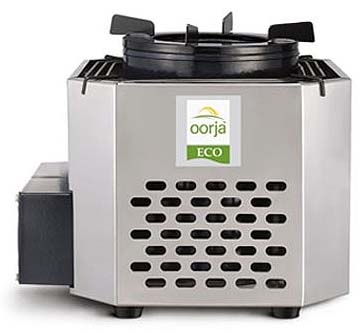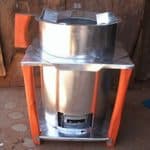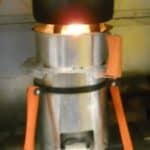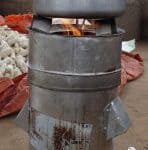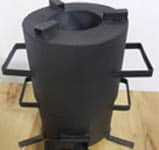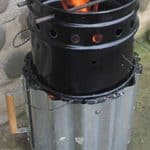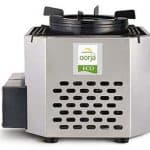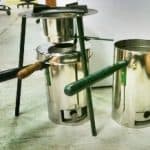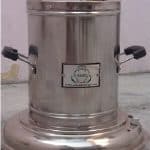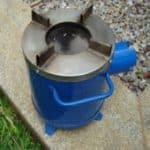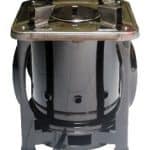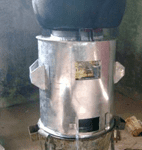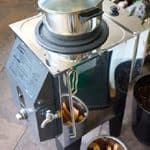Gasifier Wood Stoves
Here are some videos and images of gasifier wood stoves built by our members. You can build or make your gasifier wood stoves from plans available in our download section.
Gasifier Wood Stoves with links to manufacturers
Africa
The Mwoto Quad3 stove is a Top Lit UpDraft (TLUD) micro-gasifier stove. It burns dry biomass fuels into char through the pyrolysis process. The Awamu Biomass Energy company is in Uganda, and the stove is based on Dr Paul Anderson’s Top-Lit UpDraft (TLUD) design which you can build yourself with his plans from our download section. These gasifier wood stoves use readily available biomass, including wood, maize cobs, twigs, uncarbonized briquettes, and papyrus, among others. Awamu stopped production of the Quad3 stove in January 2014.
The Troika Bingwa stove is a Top Lit UpDraft (TLUD) gasifier cookstove made by Awamu Biomass Energy Ltd in Uganda. The stove uses pyrolytic gasification technology for exceptionally clean burning of inexpensive agricultural residue or free thick, dry biomass fuels. The Troika stove is a version of the QUAD3 stove with three legs and an easier reactor (pot support). One hundred per cent locally made and is appropriate for households and businesses with access to biomass fuels.
The MWOTO gasifier wood stoves were developed within the ‘Promoting Improved TLUD Cookstoves in Uganda” project by CREEC. It’s one of the Biomass Energy Initiative for Africa (BEIA) projects running across Africa. The gasifier stoves are of steel. CREEC has trained about 80 tinsmiths to manufacture these stoves in the districts of Mbale, Arua, Wakiso and Kawempe, Nakawa, Entebbe and Kisenyi divisions of Kampala. The MWOTO was designed by CREEC and Professor Anderson from the USA from the 2008 champion stove model. It was first introduced to the Ugandan market in September 2011, and the project targets tinsmiths and people who use biomass to cook.
Africa
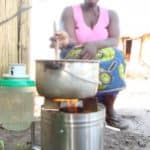
Another famous line of gasifier wood stoves is the Peko Pe, designed by the Norwegian architect Paal Wendelbo in the 1920s and used in Uganda’s refugee camps. In the native local language, Peko Pe means “no problem”. The stove is a Top Lit Up Draft, Natural Draft or TLUD ND. Additionally, it will burn Maize cobs, wood chips or chunks, ground nuts, grass and more. The Peko Pe mission aims to reduce mortality in women and children, providing a clean, burning, fuel-saving cooking stove which decreases smoke while cooking. As a result, Project OSCAR in Zambia has trained people in producing gasifier wood stoves for health and sustainability reasons.
The Jiko Bomba “Stove Pipe” is made by Kiwia & Laustsen Ltd in Tanzania. The stove is marketed by TREE Ltd. With support from the Department of Agriculture of the United States and Partners for Development. The stove uses pellets as fuel from various crop residues in Tanzania, such as rice bran, corn, sunflower, cashew nuts, coffee, castor etc. Partners for Development and its collaborators launched the agricultural fairs in August 2011 in the Singida region, from Shinyara to Arusha.
Costa Rica
Art Donnelly pioneered it from Seachar.org. These gasifier wood stoves use biomass gasification technology and also produce biochar. Biochar is a fine-grained, porous charcoal used as a soil amendment. The stove uses recycled material. It is larger than most TLUDs as it uses a 20-litre (5 ‐gallon) drum t as its fuel chamber.
India
The Oorja Pellet Stove is perhaps one of the best-known TLUD gasifier wood stoves. Marketed by First Energy Pvt. Ltd. An alternative energy company based in Pune, India. First Energy, launched in 2006 through B.P. energy, is a 100% subsidiary of British Petroleum. Unlike natural draft’ stoves, this swanky unit looks attractive and is fan-assisted (rechargeable NiMH battery pack). The combustion chamber is also ceramic with a cast iron bottom grate.
Servals Automation Pvt Ltd, based in Chennai, makes the Servals TLUD Gasifier Stove. It is a social enterprise manufacturing socially relevant products. It focuses primarily on providing clean, green, affordable and sustainable energy for cooking and lighting purposes. The present design used by Servals is by Dr Paul S Anderson of the U.S., with initial financial support for the Chennai project by the Rotary Club of Bloomington-Normal Sunset (Rotary District 6490 – East Central Illinois). Servals team up with NGO implementation partners to deploy these stoves in communities. The User Feedback Study from 50 households provides insight into how effective gasifier stoves are, particularly the Servals TLUD.
India

Samuchit Enviro Tech in Pune, India makes the Sampada Gasifier Stove. The metal stoves are portable and fueled by dry woody twigs, wood shavings or wood chips. One full fuel charge keeps the stove in operation for about 1 hour. The charcoal left behind in the fuel holder after the stove operation is a valuable by-product. The company also makes several other products, including water heaters, large gasifier wood stoves for canteens, caterers or roadside eateries.
Shakti Rice Husk Gasifier Stove by Sasoenergy in India. Claims 1 Kg of Rice husk will provide efficient burn for 70 minutes (it can be more/less, depending on rice husk quality). Also, Sasoenergy believes in empowering women to address their immediate needs and to build long-term clean cooking solutions for the future. They also make gasifier wood stoves that hold a 700-gram load and are natural draft top loading for continuous operation. No prices, but contact details are on the site.
Harith Avani Technologies make the Super Turbo Wood Stove in Bengaluru, Karnataka, India. There are several different sizes, but this one is available with a ttop-loadingsingle pot design. Coconut shell, wood chips, and pellets fuels this unit. The size is suitable for families of 3-4 members. Weight is 4 K.G., dimensions of 1 X 1 Ft. One of the most robust and straightforward wood gasifier stoves designs.
Indonesia
The Prime Square gasifier wood stove is previously known as the UB.03-1 Biomass Stove. Dr M Nurhuda invented it and tens of thousands have sold. These wood gasifier stoves used pre-heating and counter-flow burning for bulky fuel and a diffuse combustion mechanism for granular fuel. Each fuel type has its combustion chamber. Woodchips, wood shavings and sticks (maximum size 2 – 4 cm) and corncobs fuel the stove. Also, leaves or plantation residues in the form of pellets, briquettes, or pellets made from a blend of biomass and coal. Additionally, the Prime Square stove can save up to 80% of fuel compared to the traditional three-brick stove. With appropriately dried fuel it operates without smoke.
Philippines
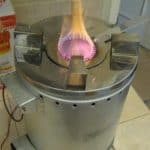
Alex Belonio developed the Belonio Rice Husk TLUD stove. This award-winning design of gasifier wood stoves provides homes with a cost-effective, clean-burning stove that uses rice husks as fuel. The husks are gasified inside a top-lit updraft (TLUD) reactor producing gaseous fuel. As a result of this great design, companies across the Philippines, Indonesia, and Cambodia are producing the stove. According to Belonio the stove can save a family of rice farmers around $150 per year in fuel expenses. If anyone knows where to purchase these stoves, please get in touch with me
United States
Wisdom Stoves is a non-profit organisation and is based in Vermont. It manufactures a variation of the t-char stove. A Wisdom Stoves outlet is in North Kinangop, Kenya. Daily operations are in Kenya, including the manufacturing, sales and distribution of gasification cookstoves. The Malaika jiko is a TLUD design; a top-lit-up-draft gasification cook stove. Wood, corn husks, cow dung, coffee husks, dried biomass briquette, and other unidentified fuels fuel this stove.
SilverFire operations are located in Eugene, Oregon. The SilverFire mission is to facilitate the availability of technologically advanced biomass clean cooking products for commercial and humanitarian use. The Water Dragon fixed chimney fan stove is similar to the Home Fire Dragon. It has an additional 33-gallon water reservoir attached to the rear of the stove. Passive heat from the chimney heats the water.
See also Gasifier Solo Camp Stoves.

